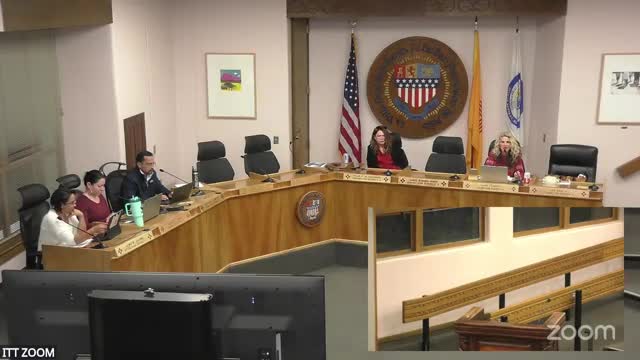City presents 2024 CAPER: HUD report shows CDBG support exceeded goals for shelter and public facilities
October 23, 2025 | Santa Fe, Santa Fe County, New Mexico
This article was created by AI summarizing key points discussed. AI makes mistakes, so for full details and context, please refer to the video of the full meeting. Please report any errors so we can fix them. Report an error »

Fabiola Chavez, director of Affordable Housing, presented the City of Santa Fe’s 2024 Consolidated Annual Performance and Evaluation Report (CAPER) at the Oct. 22 Quality of Life Committee meeting. The CAPER summarizes HUD‑funded community development activities for the program year covering July 1, 2024 through June 30, 2025 and is required before the city submits annual reports to HUD.
Chavez told the committee that resources made available for the CAPER reporting year totaled $897,535. That total included a 2024 HUD allocation of $623,117, approximately $200,000 in program income and $74,418 rolled over from 2023. The CAPER compares the city’s annual action‑plan goals to what subrecipients actually delivered.
Notable CAPER outcomes reported to the committee included: the city exceeded its goal for supportive services (the annual action plan goal of about 800 recipients was exceeded; Chavez reported several thousand recipients in aggregated service counts), and the city exceeded its goal to expand overnight shelter capacity: a stated goal of 400 was reported as serving 841 individuals through CDBG‑funded programs. Owner‑occupied housing rehabilitation had a goal of 20 households; the CAPER documented 17 households served. The CAPER also reported expansion of public facilities and infrastructure with a goal of 500 households and an outcome of 554 households assisted.
Chavez reported HUD‑required demographic detail for program beneficiaries. The CAPER counted 4,947 individuals in the demographic dataset shared with the committee; about 80% of those beneficiaries identified as Hispanic and 20% as non‑Hispanic. On housing rehabilitation and production, the CAPER showed 17 existing units rehabilitated and two newly produced units for low‑to‑moderate income households; the households served spanned extremely low, low and moderate income brackets.
The CAPER was made available for a 15‑day public comment period (Oct. 7–22) as required by HUD; Chavez said no public comments were received during that posting window. The presentation prompted brief committee discussion about program eligibility and whether sidewalk repair could be incorporated into rehabilitation programs; councilors asked staff to check legal and programmatic constraints on the use of CDBG dollars for sidewalk repairs.
Chavez closed by noting the CAPER is an annual accountability document that ties HUD funding to outcomes and citizen participation; staff will submit the CAPER to HUD after the hearing cycle concludes.
Sources: CAPER presentation to Quality of Life Committee, Oct. 22, 2025; presentation slides and committee Q&A.
Chavez told the committee that resources made available for the CAPER reporting year totaled $897,535. That total included a 2024 HUD allocation of $623,117, approximately $200,000 in program income and $74,418 rolled over from 2023. The CAPER compares the city’s annual action‑plan goals to what subrecipients actually delivered.
Notable CAPER outcomes reported to the committee included: the city exceeded its goal for supportive services (the annual action plan goal of about 800 recipients was exceeded; Chavez reported several thousand recipients in aggregated service counts), and the city exceeded its goal to expand overnight shelter capacity: a stated goal of 400 was reported as serving 841 individuals through CDBG‑funded programs. Owner‑occupied housing rehabilitation had a goal of 20 households; the CAPER documented 17 households served. The CAPER also reported expansion of public facilities and infrastructure with a goal of 500 households and an outcome of 554 households assisted.
Chavez reported HUD‑required demographic detail for program beneficiaries. The CAPER counted 4,947 individuals in the demographic dataset shared with the committee; about 80% of those beneficiaries identified as Hispanic and 20% as non‑Hispanic. On housing rehabilitation and production, the CAPER showed 17 existing units rehabilitated and two newly produced units for low‑to‑moderate income households; the households served spanned extremely low, low and moderate income brackets.
The CAPER was made available for a 15‑day public comment period (Oct. 7–22) as required by HUD; Chavez said no public comments were received during that posting window. The presentation prompted brief committee discussion about program eligibility and whether sidewalk repair could be incorporated into rehabilitation programs; councilors asked staff to check legal and programmatic constraints on the use of CDBG dollars for sidewalk repairs.
Chavez closed by noting the CAPER is an annual accountability document that ties HUD funding to outcomes and citizen participation; staff will submit the CAPER to HUD after the hearing cycle concludes.
Sources: CAPER presentation to Quality of Life Committee, Oct. 22, 2025; presentation slides and committee Q&A.
View the Full Meeting & All Its Details
This article offers just a summary. Unlock complete video, transcripts, and insights as a Founder Member.
✓
Watch full, unedited meeting videos
✓
Search every word spoken in unlimited transcripts
✓
AI summaries & real-time alerts (all government levels)
✓
Permanent access to expanding government content
30-day money-back guarantee

